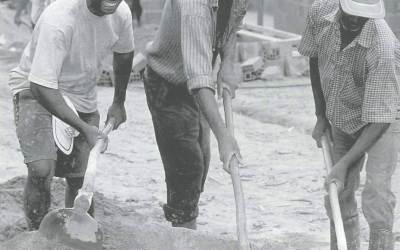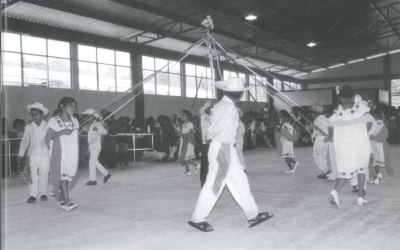Latin American Philanthropy in Changing Times
When I first moved to Latin America fresh out of college in 1981, I was filled with ideals about working for human rights and social justice, like many of my generation. If anyone had suggested that I consider working in philanthropy, I would have scoffed at the idea. Filantropia at that time conjured up images of factory owners who offer food baskets to their workers each Christmas instead of decent salaries, or ladies who attend the charity balls and auctions that fill the society pages of major newspapers. Promote philanthropy, for social change? You must be kidding!
Ten years later, I was back in the region working for a private foundation. Philanthropy began to take on a new meaning for me, as well as for many of my Latin American friends and colleagues. Today, as you will see in the pages of this ReVista, philanthropy includes factory owners who involve their companies in public education reform, business associations that campaign against child labor, women of privilege who run modern foundations (and don’t have time for charity balls), students and housewives who get out the vote, and entire communities organizing against hunger and crime. In other words, filantropia is shifting from charity to solidarity, to the giving of time and money for the common good.
So, what happened? It’s true that the opening of markets and privatization of public enterprises brought tremendous gains to some sectors of Latin American private business, as well as bolstering overall growth through much of the 1990s and reviving the flow of international investment. Along with increased private wealth came increased public expectations that the corporate sector (and the rich in general) be more socially responsible. Increased private sector investment towards resolving this region’s many social problems did occur in some countries, often in response to the demands of new social movements and NGOs. Given the limited credibility of most public sector institutions and political parties in the region, civil society organizations supported largely by their members or private donors have also moved beyond protest to assume greater responsibility for a wide array of public goods, from the protection of basic citizen rights to the delivery of social services.
Yet, how realistic are these expectations? Now that the economic boom in many countries has turned to bust, will private philanthropy dry up as well? Is the concern for corporate social responsibility reflected in sustained business practice, especially when owners and their workers fall on harder times? Do the younger generations of wealthy Latin Americans give away more or less than their forebears, and do they do so in more strategic ways? Are poor communities today better able to tap new sources of external support, as well as pool their scarce resources for addressing local needs?
These are the kinds of questions addressed in this ReVista by a diverse group of philanthropists, business and civil leaders and scholars from different disciplines. Through essays, case studies and personal testimonies, the authors discuss the new forms of corporate and elite philanthropy that have emerged in the region, as well as old and new forms of community organization and self-help, and potential relationships between the two. They also talk about the challenges and rewards of giving time, rather than money, and discuss innovative programs that recruit and mobilize volunteers. A special section focuses on Brazil, a country that has some of the world’s highest levels of social inequality and violence, but also some of the most significant private and multi-sector efforts to address these problems.
What can we learn from these experiences? First of all, contrary to what is often believed, Latin America clearly has a long history of voluntary and charitable activity and civic engagement. Varied traditions of community self-help and solidarity stretch back to the region’s pre-Hispanic cultures, and include the mutual aid societies, trade unions and professional associations that emerged in the 19th and early 20th centuries. This history also includes the social movements and NGOs that emerged on the scene in the late 20th century, involving millions of poor people, women and other formerly excluded members of society.
Of course, the Catholic Church and its doctrines have played a leading role in the development of Latin American philanthropy. As Felipe Portocarrero and others point out, the first public-private “partnerships” in this region date to colonial times, when the Church had primary responsibility for most education and social welfare. Today Catholic churches, schools and charities are still leading recipients of private donations and public subsidies in the region. At the same time, over the last century the Church has evolved dramatically in its defense of equity and social justice, and church support underlies many of the region’s human rights organizations and grassroots social movements.
Despite this rich history, most of the authors here accentuate the new over the old, and argue that major changes have occurred in Latin American philanthropy over the past decade. What is so new here? Based on the limited empirical evidence available, there does appear to be a significant increase in the amount of secular philanthropic activity in the region, including the number of new private and corporate foundations and new forms of private giving and volunteering. Surveys in Argentina, Brazil, Chile, Colombia and Peru show that 80 to 95% of the largest corporations undertake some kind philanthropy, including financial or in-kind donations, employee volunteer programs and direct operation of social programs. Mexico and Colombia today boast nearly 100 grant making foundations each, while Argentina has at least 40 and Brazil more than 30, some of which are active partners with the likes of Ford and Rockefeller. Grant makers’ associations such as GIFE in Brazil and CEMEFI in Mexico also play a new role in shaping the field and promoting a more favorable legal and tax environment for philanthropic activity.
Beyond Noblesse Oblige?
Among the new generations of wealthy Latin Americans, various authors cite an important cultural change. While religious obligation has long motivated the privileged to be charitable, for example, Roberto Andrade argues that a new sense of civic obligation is evident, based on a greater degree of solidarity and shared purpose with citizens of less privileged backgrounds. This is expressed in the preference of corporate leaders for the term “social responsibility” rather than philanthropy, and in their efforts to move beyond what Manuel Arango calls “checkbook philanthropy”, towards more strategic forms of giving and alliance-building.
Nonetheless, recent research suggests that the discourse of social responsibility has evolved much further than actual practice. Latin America lags well behind the developed world and also many developing regions in overall levels of private giving. In most countries, elite and corporate giving in the 1990s remained fairly low in relation to profits, and it remains extremely sensitive to fluctuations in the global and national economy. Furthermore, “strategic philanthropy” appears to remain the exception rather than the rule, as most private donors make little effort to evaluate the impact of their giving or incorporate it into sustained company practice.
Existing data also suggest that most of Latin America’s elite donors remain oriented towards basic charity, or activities that primarily benefit their own social group, such as private schools and universities, recreational and social clubs and the fine arts. These are all worthy endeavors, and represent patterns of giving similar to those in the U.S. and other wealthy countries. However, in societies with such severe disparities and such limited public sector resources and capacity, this pattern is of greater concern to policymakers and civil society leaders. It also presents an obstacle to obtaining the tax incentives and favorable legal regimes that many philanthropists call for.
Nonprofits, Communities and Volunteers
As Peggy Dulany notes at the outset, the concept and practice of philanthropy is more extensive among poor communities than among the rich in Latin America. However over the past two decades there has been an explosion in the number and variety of private, nonprofit organizations emerging in the region. These groups address issues of critical importance to people’s daily lives and mobilize thousands of new citizens. Researchers with the Johns Hopkins University Comparative Nonprofit Sector Project identified 190,000 nonprofit organizations in Brazil in 1995, 135,000 in Colombia and 110,000 in Peru, and this data under-represents the most informal and locally based associations.
Nonetheless, the relationship between philanthropy and civil society remains problematic. Associative life in this region is tremendously fragmented and disperse. Most of “civil society” is also self supporting, with neither the State nor economic elites making significant contributions. In practice, this means most nonprofit organizations are institutionally precarious and resource poor, with a limited capacity to influence public agendas, hold governments accountable or shift the distribution of resources and power within their communities.
Private philanthropy provides only a small fraction of the income and resource needs of nonprofit organizations in this region. According to the Hopkins project, in Latin America most nonprofit income (74.4%) comes from fees and sale of services, while just 15% comes from the public sector and 10.3% from private donations. When international donations are separated out, the overall share of national private philanthropy, and national government support for secular nonprofits, decline to single digits.
Most estimates of the size and scope of the nonprofit sector in Latin America do not include the value of volunteers. Indeed, researchers have yet to adequately assess the amount of non-elite giving and volunteering in this region, or even to clearly define it. However, national surveys in Argentina, Brazil, Peru and elsewhere have helped to dispel the notion that volunteering is just the pastime of wealthy societies or individuals. Overall, the average percentage of adults who do volunteer work in Latin America is 28%, compared to 24% in France (but 55% in the United States). Peru leads the region with 34% of its adult population volunteering in 2000, while 51% made donations (financial or in-kind). In Brazil 50% of adults made donations (21% financial) and 22.6% did volunteer work. Interestingly, people from the lower middle classes and the working poor appear to volunteer most.
Despite this voluntary spirit, until recently there were few organizations with formal programs to recruit, train and use volunteers in a sustained way. This has also changed, as entities such as the Hogar de Cristo, Opción Colombia and the Futbol y Barrios program mobilize young people to work with poor communities and help the needy.
Transparencia and similar organizations mobilize volunteers not only to address social welfare needs, but also defend democracy and human rights.
Nonetheless, much of the voluntary activity of the poor in Latin America might be best classified as self-help, involving activities aimed at improving the educational, nutritional and income levels of their own families and neighbors. There are still relatively few wealthy people or foundations that support sustained efforts to improve economic opportunities for the poor. Even fewer national donors are willing to support organizations that defend human rights, women’s rights and opportunities, or work against racial and ethnic discrimination. For the most part, both poor people’s organizations and those who advocate for social justice continue to depend on their members, their local parishes, or a small number of foreign donors.
In recent years, however, the authors here do point out some trends that have helped communities increase their resources and strengthen their self-help capacity. Community foundations, such as the Puerto Rico Community Foundation and the Fundación Comunitaria del Bajío in Mexico (see ReVista, Fall 2001) have boards that combine business and community leaders, and pool resources from many small donors as well as large contributors. And “diaspora philanthropy” today involves not only wealthy Latin Americans in New York and Miami, but also poor and middle class immigrants who found new opportunities in the U.S. and are able to give something back to their communities of origin.
Philanthropy, Equity and Empowerment
In his closing reflections, Lincoln Chen argues that inequality–socially intolerable and morally unacceptable inequality–is the major challenge of our times. Therefore, reducing the tremendous gap between rich and poor should be the major challenge of the next wave of philanthropy. But is this not a fundamental contradiction? Can those who most benefit from the unequal distribution of wealth and other resources really be expected to reverse this situation?
Notably, most of the Brazilian authors here believe this is the case. The violence and social decay in that country, they say, has galvanized a growing number of wealthy and professional Brazilians to work for social change, as expressed in the work of Instituto Ethos, the National Forum of Social Leaders and other venues. However, they also note that many of these efforts began in response to pressures from organized civil society, from religious leaders, and from their own employees and consumers. Such pressures included the anti-corruption movement that impeached President Coller, the massive Campaign for Hunger, the land rights movement, and numerous other grassroots efforts. More recently, protests have been joined by tentative new alliances between these actors to achieve broader political and social change.
Yet private actors, however broadly allied, cannot assume sole responsibility for tasks that are still primary functions of the State. In Latin America these include basic education and health care as well as legal protection against discrimination. Another change in Brazil, according to Ruth Cardoso, is that the government has taken steps to both encourage private initiative in the social sphere, and establish effective partnerships with business and civil society. Similar efforts have been made in Chile, Colombia and elsewhere, and enjoy support from the IDB and the World Bank. Nonetheless, as Andres Thompson notes, “partnership” is easier said than done, given historical mistrust among the parts and the weakness of most representative institutions. Even where private foundations or NGOs have been successful partners with government in social policymaking, Maria Cristina Rojas raises important questions about what this means for longer-term state capacity and democratic accountability. Does the delegation of public responsibilities and funds to private intermediaries, however efficient and well intended, represent a decline in the public’s ability to hold them accountable? Over the long run, does it strengthen, or undermine, the legitimacy and capacity of the public sector?
So ultimately, can philanthropy really help address the region’s persistent poverty and social injustices? Reading through this ReVista, the answer here appears to be yes, but not alone. Partnerships are needed, in which government is an active and legitimate partner. Political will is needed, on the part of the haves, to recognize and address the root causes of today’s problems. And empowerment is needed, empowerment of the have-nots, to become more equal partners and to make themselves a place at the table.
Spring 2002, Volume I, Number 3
Related Articles
Program on Philanthropy
Harvard’s David Rockefeller Center for Latin American Studies (DRCLAS) and the Hauser Center for Nonprofit Organizations have combined forces to establish the Program on Philanthropy …
New directions in Latin American
It was in Amsterdam in the winter of 1978 when I first came into contact with an animal that would later become a monster with multiple heads. It was a time of exile and hundreds of people were …
The Societies Of St. Vincent De Paul In Mexico
The Mexican volunteers established institutions such as schools, shelters, soup kitchens, lending libraries, and credit unions for the urban poor. They pioneered adult education and helped …




